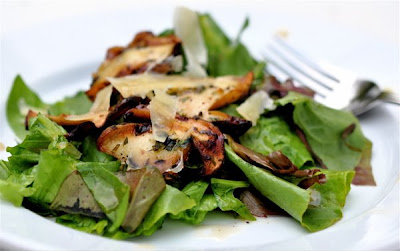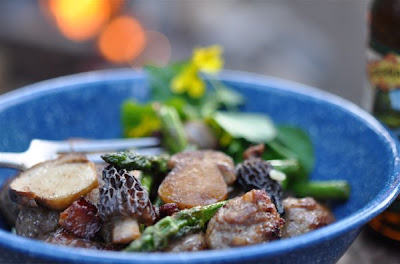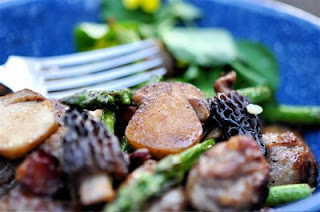 FISHING IS ALWAYS on the menu when we visit relatives in Colorado. Usually we pan-fry our trout, but with a haul of wild mushrooms gathered on a hike in the Gore Range the previous day, including oyster mushrooms and aspen boletes (known to locals as orange-caps), we decided a stuffed baked trout was the way to go.
FISHING IS ALWAYS on the menu when we visit relatives in Colorado. Usually we pan-fry our trout, but with a haul of wild mushrooms gathered on a hike in the Gore Range the previous day, including oyster mushrooms and aspen boletes (known to locals as orange-caps), we decided a stuffed baked trout was the way to go. 
A word about aspen boletes (Leccinum insigne): Most books and web sites list this species as edible. Coloradans regularly eat this common variety of porcini.  However, the Colorado Mycological Society recommends caution. Every year the Rocky Mountain Poison Center receives complaints of gastro-intestinal distress following the ingestion of orange-caps, with some cases requiring hospitalization. In the Northwest there are similar complaints that derive from the consumption of Leccinum aurantiacum. I’ve talked to a mycologist who believes that a small percentage of the population at large—maybe just a few percent—is allergic to the genus Leccinum in general. Most people seem to eat these mushrooms without difficulty, and indeed, immigrants from mushroom-hunting cultures (e.g., Eastern Europeans) eat them with abandon. As with any new species of edible wild mushroom, it’s recommended that you nibble on just a little bit (cooked of course) to make sure you’re not allergic.
However, the Colorado Mycological Society recommends caution. Every year the Rocky Mountain Poison Center receives complaints of gastro-intestinal distress following the ingestion of orange-caps, with some cases requiring hospitalization. In the Northwest there are similar complaints that derive from the consumption of Leccinum aurantiacum. I’ve talked to a mycologist who believes that a small percentage of the population at large—maybe just a few percent—is allergic to the genus Leccinum in general. Most people seem to eat these mushrooms without difficulty, and indeed, immigrants from mushroom-hunting cultures (e.g., Eastern Europeans) eat them with abandon. As with any new species of edible wild mushroom, it’s recommended that you nibble on just a little bit (cooked of course) to make sure you’re not allergic.
For this recipe it’s best to de-bone the trout, Here’s a helpful YouTube video.
 2 pan-sized trouts, butterflied
2 pan-sized trouts, butterflied
2 pieces bacon
1/4 cup onion, diced
1/2 cup mushrooms, chopped
1 tbsp fresh thyme, chopped
1 heaping tbsp parsley, chopped
1 slice bread, toasted and crumbled
lemon for juice and garnish
 salt and pepper to taste
salt and pepper to taste
Fry the bacon and remove from pan when crispy. Crumble bacon into a bowl. Saute onion in bacon fat a couple minutes over medium heat, then add mushrooms and cook for another four or five minutes, making sure mushrooms expel their moisture. Add thyme and cook for one more minute. Spoon onion-mushroom mixture into bowl with bacon and add bread crumbs. Mix together. Squeeze lemon juice over butterflied trouts and season with salt and pepper. Spread half the stuffing onto lower half of one trout; repeat with other trout. Fold over each trout like a sandwich and secure with toothpicks. Place on greased foil in a broiling pan and bake at 400 degrees for 15 minutes.







 3
3

















